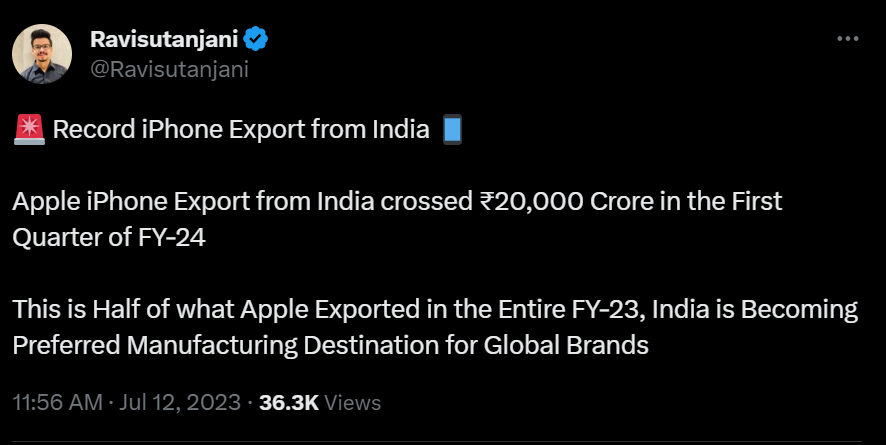
Chief Executive Officer of Apple Tim Cook waves during the opening of Apple’s first retail store in India, in Mumbai on April 18, 2023. Apple opened its first retail store in India on April 18, underscoring the US tech titan’s increasing focus on the South Asian nation as a key sales market and alternative manufacturing hub to China. (Photo by Punit PARANJPE / AFP)
India will drive Apple’s revenue in the next 5 years.
- India will be a significant driver of Apple’s revenue and installed based growth in the next five years.
- In the next ten years, the revenue contribution would be the “equivalent to Apple ramping up an entirely new product category.”
Ahead of its flagship store launch in Mumbai in April this year, iPhone maker Apple Inc announced a record US$6 billion in sales from India. Revenue from the South Asian nation also grew exponentially – by nearly 50% in the first three months of this year, compared to US$4.1 billion a year earlier.
The sales and revenue growth indicate the increasing importance of India as a market for iPhone makers. Frankly, CEO Tim Cook has been seeking to accelerate growth in a country of 1.4 billion where the company’s smartphones and computers have never held more than a minuscule market share due to their high cost.
Since Apple started reducing its reliance on China alone, the tech giant has identified India’s expanding middle class as an attractive opportunity while actively adding local production at an increasing rate. Apple, which has so far relied on retail partners and online sales in India, only opened its first official retail store in the country in April this year.
Considering this, Morgan Stanley analysts said in a note on Monday that for Apple, India will be a significant driver of the company’s five-year revenue and installed base growth. The outlook is that in the next five years, the country could account for 15% of Apple’s revenue growth — in contrast to 2% in the past five years and US$6 billion today — and 20% of the company’s installed base growth.

Record iPhone Export from India. Source: Twitter
What is more interesting is that the revenue growth for Apple from India in the next ten years, according to Morgan Stanley forecasts, would stand at US$40 billion. As analysts put it, that growth would be the “equivalent of Apple ramping up an entirely new product category.” The analysts also cite several factors in their assessment, including India’s improved electrification and Apple’s apparent efforts to build a manufacturing and retail presence there.
Separately, a survey commissioned by Morgan Stanley suggested that Indian consumers have an increased desire and ability to purchase iPhones. However, Morgan Stanley’s analysts also warned that if India fails to meet its economic and demographic growth marks, “we wouldn’t expect Apple to be as significant of a beneficiary in India.”
Overall, Morgan Stanley’s fundamental thesis is bullish. “All-in, this means that India will be just as important to Apple and [its revenue and sales] growth algorithm over the next 5+ years as China was in the last five years, something we believe the market underappreciated today,” the analysts said.
It is, however, worth noting that Apple’s India push also means braving risks such as the country’s notoriously high import duties for everything from components to finished products, which affect retail prices and demand. The government is also known for sudden shifts in rules and regulations, which can expose companies to unexpected costs. Yet the market’s growth potential makes it difficult to ignore.
The rise of Apple and its revenue thanks to India
Experts reckon India is at an inflection point, where China was in July 2008 when Apple opened its first retail store there. Bloomberg stated in a report that the 50% climb in sales for the period ended March is an impressive jump given the global slump in gadget sales across all categories.
Even then, it only makes up 1.6% of company-wide revenue and around 8% of the scale of what the iPhone maker currently gets in Greater China. Opening stores in April— in Mumbai and New Delhi — is seen as driving business in an important market or simply jumping on the bandwagon of existing growth.
All of these are taking place amidst Cook’s push for suppliers such as Foxconn Technology Group, Wistron Corp., and Pegatron Corp. to ramp up output in the country. Apple has a minuscule share in India, about 4% of the country’s nearly 700 million smartphone users.
Cheaper local brands and Chinese and South Korean manufacturers lead the world’s second-biggest mobile market. The upside, however, is that the tech giant ranked first in unit sales of devices above US$365 last year, according to researcher Counterpoint.
READ MORE
- Strategies for Democratizing GenAI
- The criticality of endpoint management in cybersecurity and operations
- Ethical AI: The renewed importance of safeguarding data and customer privacy in Generative AI applications
- How Japan balances AI-driven opportunities with cybersecurity needs
- Deploying SASE: Benchmarking your approach


